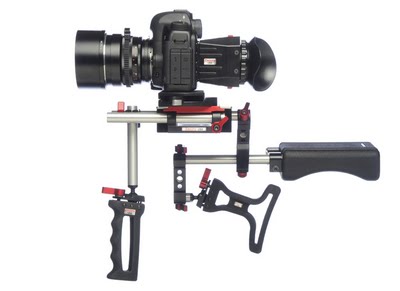Great Lens Adapter Solution
/Great Lens Adapter Solution
I recently shot a project with this package and I really enjoyed working with it.
This is a Sony EX3 and a P+S Technik Pro35 joined together with the Fujinon B4 Adapter. The camera package was rented from my friends at Tamberelli Digital in Manhattan and the support and service they provided was top notch. The lens in the pic is one of the new Zeiss Compact Primes - extremely sharp and well matched lenses but the wildly varying maximum apertures could be a potential problem - 18mm T3.6, 25mm T2.9, 35mm T 2.1, 50mm T1.5, 85mm T1.5. For this project, luckily it wasn't such an issue. This version of the Pro35 is made for 2/3" cameras that have a B4 mount so you need the Fujinon to adapt it to the EX3's Mini Bayonet. There is a new EX3 Version of the Pro35 available that works with a relay lens to optimally get the front lens' entire field of view onto the 1/2" chipset. That product wasn't available at the time so after some testing, I found this to be a fantastic solution. Because the Pro35 is made to project the front lens' image onto the larger 2/3" chip, there is a crop factor when used with the EX3. By my calculations, I thought it would be about x2.9 but the B4 adapter pushes the image plane farther away from the sensor, thus making it smaller, thus reducing the crop factor. I basically doubled the focal length of the primes and knocked a little off, finding that to be pretty accurate.
Using the very handy pCam software, here's what a 25mm at 5' would look like with the Pro 35 on a 2/3" camera:
And this is approximately what the same 25mm looked like on the 1/2" EX3 with the Fujinon B4 adapter. As you can see, there is a crop but it's not too bad.
My biggest issue with Lens Adapters is that they're so long and cumbersome and without a lot of additional hardware workarounds, they leave the camera very front heavy and unwieldy.
Maybe this is an extreme example, but who would want to operate something like this? Is there a camera in there somewhere?
Even this was not without it's headaches. Remember this guy? Good old MovieTube.. I don't miss you. I'm sure someone will be offended that I don't like the MovieTube so I'll go ahead and apologize in advance... It was a technological stepping stone. A really awkward, unwieldy, heavy, cumbersome stepping stone.
There's also focus issues with lens adapters as you have 3 potential places for de-focus: the front lens, the back focus on the adapter, and the stock lens. When you're running and gunning, this can really slow things down. If I can have it my way, I'm going to burden my brain with as few hardware related thoughts as possible so I can focus on making effective creative decisions. I think Lens Adapters are a great solution but can also be a lot of headaches (and back aches!). Because the Pro35 bypasses the stocks lens and has such precise controls, I found it to be a lot more comfortable to operate and with less things to worry my brain about. With the Zacuto plate, shoulder pad, and handles, the rig effortlessly went from studio mode to handheld as fast as we could get it off the sticks. That was awesome. Definitely the biggest issue with this setup is the crop factor. Without a real relay lens, your 18mm is more like a 35 or a 40. That's wide but not really wide enough in a tight space or if you have to get exceedingly close to your subject. Because the Pro35 pops off as if it were just another B4 lens, going back to the stock lens was as fast and painless as a lens change. Obviously the colorimetry between the two is quite different so my workaround was to paint a scene file to match the EX3 lens as closely to the Zeiss on the Pro35 as I could. When you're super wide, you aren't really taking advantage of the depth of field characteristics anyways so I found that by matching a color chart on the stock lens to the lens adapter and taking out some detail, the match was actually quite close and changing between the two was fast a normal lens change.
Given that with a lens adapter you're usually trying to create as much depth of field as possible, maybe this rig's telephoto effect is actually an advantage? For this project it was a great solution and got me images that made me and the client very happy. Will definitely be using this package again.













 © 2021 Bennett Cain / All Rights Reserved /
© 2021 Bennett Cain / All Rights Reserved /